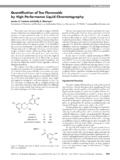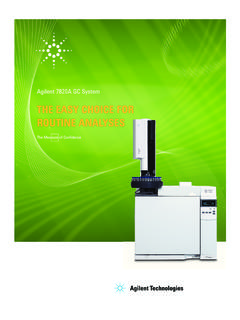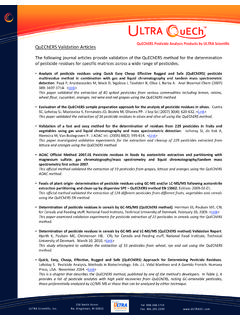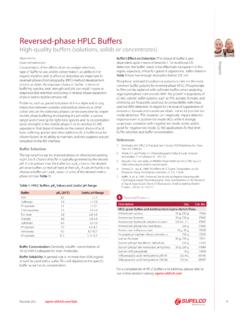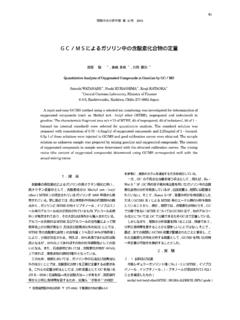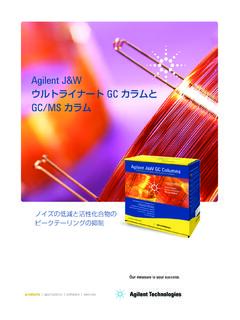Transcription of Solid phase microextraction (SPME) applied to …
1 Journal of the Science of Food and AgricultureJ Sci Food Agric83:1037 1044 (online: 2003)DOI: phase microextraction ( spme ) applied tohoney quality controlLara Piasenzotto, Luisa Gracco and Lanfranco ConteFood Science Department, University of Udine, Via Marangoni 97, I-33100 Udine, ItalyAbstract: The assessment of the botanical origin ofunifloral honeys is an important application in foodcontrol. The current official methods mainly use pollen analysis. The aim of this paper is to present anSPME analytical approach to the study of honey volatiles. Honey samples (40) obtained from hive sitesin different regions of Italy were analysed.
2 The samples had six different botanical origins: citrus (five),chestnut (10), eucalyptus (eight), lime tree (11), thyme (two) and dandelion (four). Melissopalynologicalanalysis was also performed. Identification of volatile compounds was carried out by spme /GC/MSanalysis, and quantitative evaluation was done by spme /GC/FID analysis for compounds with well-resolved peaks. Using the spme method, all samples with the same botanical origin gave remarkablysimilar GC profiles. Some volatile compounds were found only in specific floral source honey samples andthus could be interesting for use as markers. 2003 Society of Chemical IndustryKeywords:unifloral honey; aroma compounds; spme ; GC/MSINTRODUCTIONThe consumption of honey in the human diet isrelated not just to the need for sugar sources; alsoof particular importance is a sort of hedonistic choicethat leads consumers to choose a well-identified kindof honey.
3 Consumer choice is linked to organolepticcharacteristics, and these depend on the botanicalorigin of the this reason, the assessment of botanical origin isan important application in food control, and a num-ber of papers on this topic are available in the literature,as recently reviewed by current officialmethods mainly use pollen analysis and organoleptictests. An interesting paper on the determination of thebotanical and geographical origin of European honeyswas published by Radovic and search for chemical approaches has been thestarting point for a number of papers that havebeen published in the past.
4 Unifloral honeys havespecific volatile compounds derived from the botan-ical origin of the nectar. For this reason, honeyvolatile fractions have been studied to authenti-cate their floral origin. New Zealand unifloral hon-eys have been characterised3 6using a continuousliquid/liquid extractor and a GC/MS identificationmethod. An optimised Likens Nickerson methodol-ogy was applied to investigate the flavour compositionof both lavender and eucalyptus honeys7and chestnutand lime tree other approach to volatile component anal-ysis is based on headspace analysis. A number oftechniques are currently available.
5 The main advan-tage of headspace analysis over the above-mentionedtechniques is that it is carried out on an untreated sam-ple. The volatile compounds of 14 unifloral sourceswere studied with a dynamic headspace gas chromato-graph coupled directly to a mass spectrometer system;a purge-and-trap injector equipped with a cold trapwas recently, the volatile profiles of authentichoney samples of different botanical and geographicalorigins were obtained by means of GC/MS. BeforeGC separation, volatiles were adsorbed on a Tenaxtrap and cryofocused in a glass-lined simple technique, Solid phase microextraction ( spme ), has recently been developed.
6 A paperpublished by Guidotti and Vitali11dealt with theapplication of spme and capillary GC/MS to honeycharacterisation. However, no quantitative data onreplicate samples or method repeatability evaluationwere aim of this paper is to present an spme analytical approach to the study of honey samples (40) from hive sites in differentregions of Italy were analysed. The samples hadsix different botanical origins: citrus (five), chestnut(10), eucalyptus (eight), lime tree (11), thyme(two) and dandelion (four). Melissopalynological Correspondence to: Lara Piasenzotto, Food Science Department, University of Udine, Via Marangoni 97, I-33100 Udine, ItalyE-mail: 2 July 2002; revised version received 25 March 2003; accepted 30 April 2003) 2003 Society of Chemical Sci Food Agric0022 5142/2003/$ ,LGracco,LConteanalysis was performed by the Istituto Nazionale diApicoltura (Bologna, Italy) in order to confirm thebotanical preparationA 3 g honey sample was weighed into a 10 mlvial, then g of anhydrous sodium sulphate ml of internal standard solution were added.
7 Theinternal standard was benzophenone (grade );the solution ( mg ml 1) was prepared by dissolving15 mg of benzophenone in 8 ml of acetone in a 25 mlvolumetric flask and diluting to the mark with distilledwater. The vial was sealed with a Teflon-coated Siliconseptum (Alltech, Milano, Italia). The vial and septum,as well as the sodium sulphate, had previously beenconditioned at 80 C analysisThe vial was conditioned at 70 Cfor30mininawater bath prior to spme headspace sampling. Thenthe spme needle was introduced through the septum,and the fibre was exposed in the vial headspace for20 min. A temperature of 70 C was maintained duringheadspace spme device (Supelco Co, Bellefonte, PA,USA) used was equipped with a fused silica fibrecoated with polydimethylsiloxane (PDMS, 100 mthick), polyacrylate (Pac, 85 m thick) or Carboxen(75 mthick).
8 The fibre was then retracted into the needle, andthe spme holder was used for GC and GC/MSVolatile compounds adsorbed on the spme fibre wereimmediately thermally desorbed in the injector port ofa GC and then separated on the GC Carlo Erba (Milano, Italia) 5300 gas chromato-graph equipped with a model SSL71 split/splitlessinjector (temperature 250 C) and a flame ionisa-tion detector (FID; temperature 250 C) was injector port was equipped with a narrow-bore( mm id) glass liner to minimise peak broaden-ing. Separation was carried out on an HP-INNOW axcolumn (30 m mm id, m film thickness;Hewlett Packard, Milano, Italia).
9 The column tem-perature was held at 50 C for 4 min, then increased to230 Cat10 Cmin 1, held at 230 Cfor10minandfinally increased to 250 Cat10 Cmin 1. The carriergas (helium) flow rate was ml min were done using the splitless system: thesplit valve was opened 3 min after injection (50:1split ratio).GC/MS analysis was done using a Varian (Torino,Italia) 3400 gas chromatograph coupled to a VarianSaturn ion trap detector. The GC column andoperating parameters were as follows. The transferline and ion trap temperatures were 260 and 170 Crespectively. The carrier gas (helium) flow rate was1mlmin 1.
10 Electron impact (70 eV) spectra wererecorded at 1 scan s 1with a filament emission currentof 10 hydrocarbon mixture fromn-C8 ton-C32 (Sigma-Aldrich, Milan, Italy) was used for relative retentionindex AND DISCUSSIONM ethodAs a first approach, three different types of fibrecoating were tested. Differences in volatile profilesfor a chestnut honey sample extracted by spme usingPDMS-coated fibre, Pac-coated fibre and Carboxen-coated fibre were studied by GC. The chromatogramobtained using the PDMS-coated fibre showed apoor profile in the early part of the trace. Basedon areas under separated chromatographic peaks,the adsorption of more volatile substances on thePac-coated fibre was generally greater than that onthe PDMS-coated fibre.
